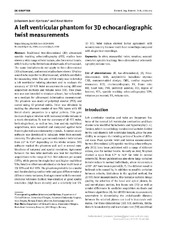| dc.contributor.author | Hjertaas, Johannes Just | en_US |
| dc.contributor.author | Matre, Knut | en_US |
| dc.date.accessioned | 2020-04-16T07:44:55Z | |
| dc.date.available | 2020-04-16T07:44:55Z | |
| dc.date.issued | 2020 | |
| dc.Published | Hjertaas JJ, Matre K. A left ventricular phantom for 3D echocardiographic twist measurements. Biomedizinische Technik. 2020:65(2); 209–218 | eng |
| dc.identifier.issn | 1862-278X | |
| dc.identifier.issn | 0013-5585 | |
| dc.identifier.uri | https://hdl.handle.net/1956/21885 | |
| dc.description.abstract | Traditional two-dimensional (2D) ultrasound speckle tracking echocardiography (STE) studies have shown a wide range of twist values, also for normal hearts, which is due to the limitations of short-axis 2D ultrasound. The same limitations do not apply to three-dimensional (3D) ultrasound, and several studies have shown 3D ultrasound to be superior to 2D ultrasound, which is unreliable for measuring twist. The aim of this study was to develop a left ventricular twisting phantom and to evaluate the accuracy of 3D STE twist measurements using different acquisition methods and volume rates (VR). This phantom was not intended to simulate a heart, but to function as a medium for ultrasound deformation measurement. The phantom was made of polyvinyl alcohol (PVA) and casted using 3D printed molds. Twist was obtained by making the phantom consist of two PVA layers with different elastic properties in a spiral pattern. This gave increased apical rotation with increased stroke volume in a mock circulation. To test the accuracy of 3D STE twist, both single-beat, as well as two, four and six multi-beat acquisitions, were recorded and compared against twist from implanted sonomicrometry crystals. A custom-made software was developed to calculate twist from sonomicrometry. The phantom gave sonomicrometer twist values from 2.0° to 13.8° depending on the stroke volume. STE software tracked the phantom wall well at several combinations of temporal and spatial resolution. Agreement between the two twist methods was best for multi-beat acquisitions in the range of 14.4–30.4 volumes per second (VPS), while poorer for single-beat and higher multi-beat VRs. Smallest offset was obtained at six-beat multi-beat at 17.1 VPS and 30.4 VPS. The phantom proved to be a useful tool for simulating cardiac twist and gave different twist at different stroke volumes. Best agreement with the sonomicrometer reference method was obtained at good spatial resolution (high beam density) and a relatively low VR. 3D STE twist values showed better agreement with sonomicrometry for most multi-beat recordings compared with single-beat recordings. | en_US |
| dc.language.iso | eng | eng |
| dc.publisher | De Gruyter | eng |
| dc.title | A left ventricular phantom for 3D echocardiographic twist measurements | en_US |
| dc.type | Peer reviewed | |
| dc.type | Journal article | |
| dc.date.updated | 2020-01-13T14:44:00Z | |
| dc.description.version | publishedVersion | en_US |
| dc.rights.holder | Copyright 2020 Walter de Gruyter. All rights reserved. | |
| dc.identifier.doi | https://doi.org/10.1515/bmt-2019-0096 | |
| dc.identifier.cristin | 1739358 | |
| dc.source.journal | Biomedizinische Technik | |
| dc.source.pagenumber | 209–218 | |
| dc.identifier.citation | Biomedizinische Technik. 2020:65(2); 209–218 | |
| dc.source.volume | 65 | |
| dc.source.issue | 2 | |
